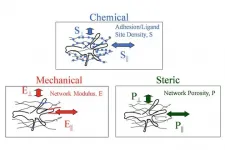(Press-News.org) New European Union regulations on batteries could offer a huge boost to the global decarbonisation mission - but only if it leverages its political and economic weight to ensure a fairer global marketplace.
According to a team of scientists and researchers writing in Science, the new regulations, due to come into force from January 2022, have the potential to unify policy on approaches such as recycling, use of recycled raw materials, and creating a circular economy.
Contributing to the study were experts at Newcastle University, the University of Birmingham, Circular Energy Storage Research and Consulting, University of California, Davis and the National Institute of Clean and Low Carbon Energy (NICE) America Research.
The European Union is a significant market for Electric Vehicles globally, and the effects of its regulation will be felt by battery supply chains in many other countries, including the United Kingdom, even though it has left the European Union.
Although these rules are both necessary and welcome, whilst well-intentioned, the researchers argue, their effects are hard to predict and could result in a competitive disadvantage for European companies. This is because the EU must operate in the global marketplace where there is an imbalance between new and mature markets and uncertainty caused by the rapid rate of growth and innovation in the lithium-ion battery (LIB) market.
China, for example, has a well-developed LIB market, with relatively strict regulations around recycling and decarbonising the supply chain. In the US, in contrast, although electrification of transport has been declared a priority, legislation to promote a circular economy in the sector is lagging behind both China and the EU.
Dr Oliver Heidrich, of Newcastle University, led the study. He says: "Balancing the challenges of climate change, sustainability and competitiveness is a difficult task. Formal assessments along the supply and value chain from raw material extraction, achieving carbon reductions targets to final disposal are needed to ensure social, environmental and economic aspects are addressed successfully".
Companies that are able to comply with more stringent regulations have a big competitive advantage in these markets. This is particularly true in China where there are well-established, tougher domestic requirements. Companies in markets where there is ready access to both virgin and recycled materials - such as China and South Korea - are also likely to have an advantage over EU companies, where supply chains are less well-developed and may still rely on imported materials.
The US shares the EU's situation with a less developed supply chain, however battery makers will retain a higher degree of freedom to operate which can be crucial for innovation in both battery technology and electric mobility.
"While it is critical to ensure a high degree of sustainability in the battery supply chain we must not forget that the end game is a decarbonised and less polluting transportation sector," says Hans Eric Melin, of Circular Energy Storage Research and Consulting. "By raising the bar to a higher level than for almost any other product there is a significant risk that the European battery industry, which is well behind global leaders, will struggle to keep up with the required pace. This could limit automotive makers' ability to produce electric vehicles at the scale required by 2030 and might also cause distortion of innovation and a slow down of investments."
Global standards, argue the researchers, are the only way to make this essential supply chain both predictable and powerful. The new, advanced standards set out by the EU, together with its significant share of the EV market, could give it leverage to lead the way in setting such standards.
"The EU Battery Regulation has admirable intentions, but unintended consequences could be felt by manufacturers, recyclers and other actors across the world. Whilst difficult to achieve, and politically challenging, a co-ordinated, global approach would ensure a more rapid and effective transition to electric transport," says Dr Gavin Harper, of the University of Birmingham
The European market can provide significant leverage to set standards across the globe in order to stimulate innovation in the areas of cascaded use and recycling and serve as a steppingstone to more formal global standards. Policies and legislations that address environmental or social issues are very much needed and do need to consider the unintended consequences as much as the in-tended consequences
INFORMATION:
* This research was supported by the UK's Engineering and Physical Sciences Research Council (EPSRC), the Faraday Institution (EP/S003053/1), and its Recycling of Li-Ion Batteries (ReLIB) project (FIRG005) led by the University of Birmingham. More information on the project can be found at http://www.relib.org
* Melin, H.E., Rajaeifar, M.A., Ku, A.Y., Kendall, A., Harper, G., Heidrich, O. (2021). 'Global implications of the EU battery regulation'. Science. DOI: 10.1126/science.abh1416
* Supplementary Materials for this paper will be published at: science.sciencemag.org/content/vol/issue/page/suppl/DC1
* The University of Birmingham is ranked amongst the world's top 100 institutions. Its work brings people from across the world to Birmingham, including researchers, teachers and more than 6,500 international students from over 150 countries.
As a newborn mammal opens its eyes for the first time, it can already make visual sense of the world around it. But how does this happen before they have experienced sight?
A new Yale study suggests that, in a sense, mammals dream about the world they are about to experience before they are even born.
Writing in the July 23 issue of Science, a team led by Michael Crair, the William Ziegler III Professor of Neuroscience and professor of ophthalmology and visual science, describes waves of activity that emanate from the neonatal retina in mice before their eyes ever open.
This activity disappears soon after birth and is replaced by a more mature network of neural transmissions ...
Using information obtained from around a dozen earthquakes detected on Mars by the Very Broad Band SEIS seismometer, developed in France, the international team of NASA's InSight mission has unveiled the internal structure of Mars. The three papers published on July 23, 2021 in the journal Science, involving numerous co-authors from French institutions and laboratories, including the CNRS, the Institut de Physique du Globe de Paris, and Université de Paris, and supported in particular by the French space agency CNES and the French National Research Agency ANR, provide, for the first time, an estimate of the size of the planet's core, the thickness of its crust and the structure of its mantle, based on the analysis of seismic waves reflected ...
For much of human history, animals and plants were perceived to follow a different set of rules than the rest of the universe. In the 18th and 19th centuries, this culminated in a belief that living organisms were infused by a non-physical energy or "life force" that allowed them to perform remarkable transformations that couldn't be explained by conventional chemistry or physics alone.
Scientists now understand that these transformations are powered by enzymes - protein molecules comprised of chains of amino acids that act to speed up, or catalyze, ...
The rapid spread of the Alpha variant of COVID-19 resulted from biological changes in the virus and was enhanced by large numbers of infected people 'exporting' the variant to multiple parts of the UK, in what the researchers call a 'super-seeding' event.
Results of the largest phylogeographic analysis ever conducted, published today in the journal Science, maps the spread of the variant (also known as lineage B.1.1.7) from its origins in Kent and Greater London in November 2020 to all but five counties in Wales, Scotland, Northern Ireland and England by 19 January.
Dr ...
Engineers at the University of California San Diego developed a soft and stretchy ultrasound patch that can be worn on the skin to monitor blood flow through major arteries and veins deep inside a person's body.
Knowing how fast and how much blood flows through a patient's blood vessels is important because it can help clinicians diagnose various cardiovascular conditions, including blood clots; heart valve problems; poor circulation in the limbs; or blockages in the arteries that could lead to strokes or heart attacks.
The new ultrasound patch developed at UC San Diego can continuously monitor ...
Irvine, Calif., July 22, 2021 - To meet an ambitious goal of carbon neutrality by 2045, California's policymakers are relying in part on forests and shrublands to remove CO2 from the atmosphere, but researchers at the University of California, Irvine warn that future climate change may limit the ecosystem's ability to perform this service.
In a paper published today in the American Geophysical Union journal AGU Advances, the UCI Earth system scientists stressed that rising temperatures and uncertain precipitation will cause a decrease in California's natural carbon storage capacity of as much as 16 percent under an extreme climate projection and of nearly 9 percent under a more moderate scenario.
"This work highlights the conundrum ...
ITHACA, N.Y. - A new method that analyzes how individual immune cells react to the bacteria that cause tuberculosis could pave the way for new vaccine strategies against this deadly disease, and provide insights into fighting other infectious diseases around the world.
The cutting-edge technologies were developed in the lab of Dr. David Russell, the William Kaplan Professor of Infection Biology in the Department of Microbiology and Immunology in the College of Veterinary Medicine, and detailed in new research published in the Journal of Experimental Medicine on July 22.
For years, Russell's lab has sought to unravel how Mycobacterium tuberculosis (Mtb), the bacteria that cause tuberculosis, infect and persist in their host cells, which are typically ...
A new study, led by University of Minnesota Twin Cities engineering researchers, shows that the stiffness of protein fibers in tissues, like collagen, are a key component in controlling the movement of cells. The groundbreaking discovery provides the first proof of a theory from the early 1980s and could have a major impact on fields that study cell movement from regenerative medicine to cancer research.
The research is published in the Proceedings of the National Academy of Sciences of the United States of America (PNAS), a peer-reviewed, multidisciplinary, high-impact scientific journal.
Directed cell movement, or what scientists call "cell contact guidance," refers to a phenomenon when the orientation of cells ...
Researchers at the University of São Paulo (USP) in Brazil investigated the effects of regular exercise on the physical and mental health of 344 volunteers during the pandemic. The study compared the effectiveness of three techniques: sessions led in person by a fitness instructor, sessions featuring an online instructor but no supervision, and sessions supervised remotely by an instructor via video call.
The two kinds of session with professional supervision had the strongest effects on physical and mental health. According to the researchers, this was due to the possibility of increasing ...
New Brunswick, NJ--Even at term, gestational age may have an impact on children's academic performance, findings of a new study suggest. The research showed an association between gestational age at term and above-average rankings in a number of academic subjects.
The study, published in Pediatrics, compared teacher-reported outcomes for 1,405 9-year-old children in the United States, analyzing performance in mathematics, science and social studies, and language and literacy, for those born at 37 through 41 weeks gestation. It found that longer gestational age was significantly associated with average or above-average rankings in all areas. It also suggested a general pattern of worse outcomes for children born at early term (37-38 weeks) and better outcomes for those born at late ...





